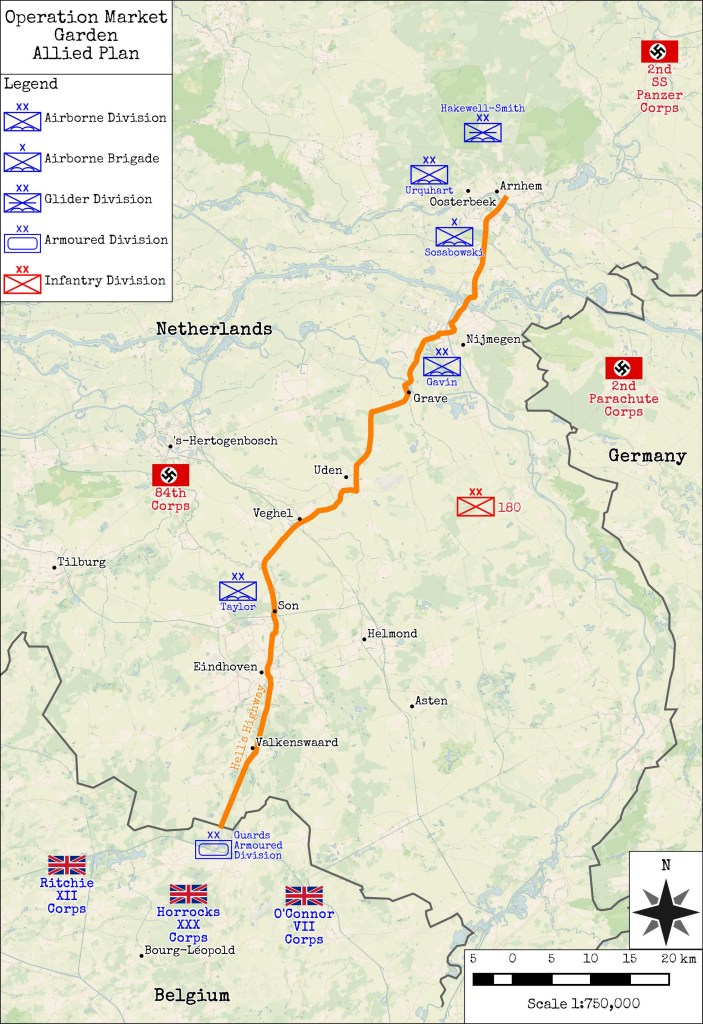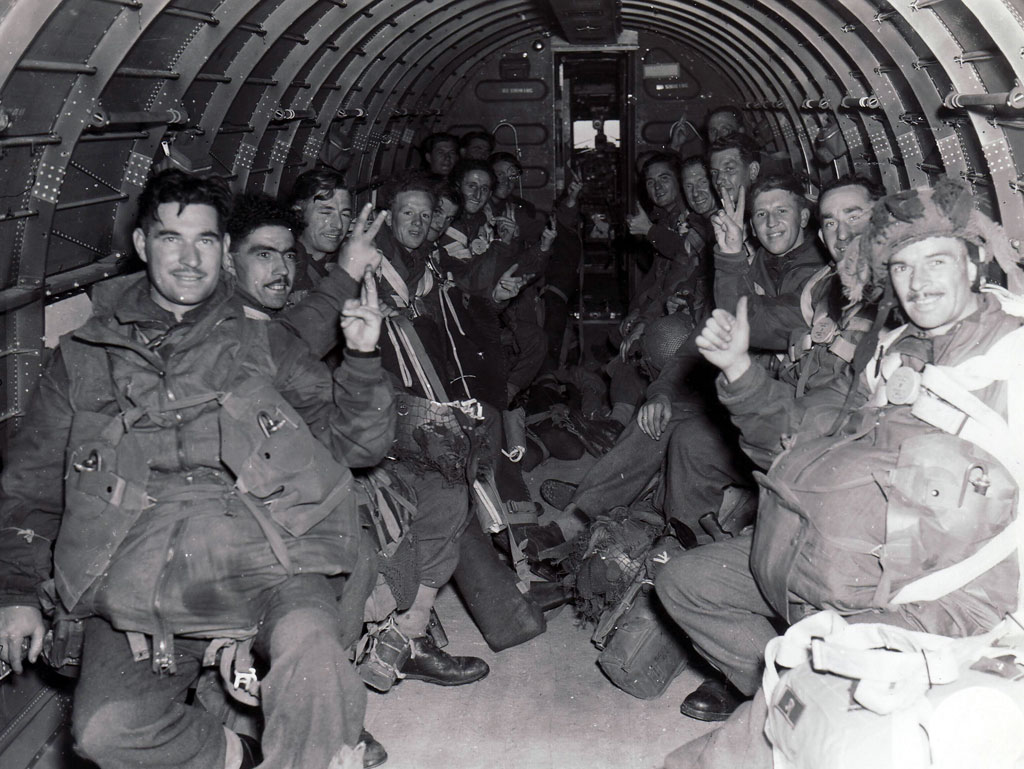
“But, sir, I think we might be going a bridge too far.” – Attributed to Lt. Gen. Frederick “Boy” Browning, commanding officer of I British Airborne Corps and overall commander for Operation Market-Garden
On May 17, 2018 – September 11 in the U.S. – Viking (a subsidiary of Penguin Random House) published the British edition of Antony Beevor’s Arnhem: The Battle for the Bridges, 1944, a new look at Operation Market-Garden, an ambitious but ill-fated bid to capture a series of bridges along a single highway in German-occupied Holland in a bid to capture a key bridge over the Lower Rhine River at Arnhem and outflank Adolf Hitler’s “Westwall” along the Third Reich’s western border.
Conceived in haste by Field Marshal Bernard Law Montgomery – Britain’s most popular commander – and approved by Gen. Dwight D. Eisenhower and his superiors in the Combined Chiefs of Staff, Market-Garden was actually a combination of two suboperations:

- Market, which was designed to use three of the First Allied Airborne Army’s six divisions (the U.S. 82nd and 101st Airborne, the British 1st Airborne and – as a follow-on force once the Allies had captured Arnhem – 52nd (Lowland) Division[1]) and the 1st Polish Brigade. The “airborne” element would, per Montgomery’s plan, seize a series of bridges over several major canals and and rivers – most notably the Waal near Nijmegen and the Lower Rhine at Arnhem – along a 64-mile-long highway
- Garden, the “ground element,” which consisted of a single corps (the British XXX) commanded by Lt. Gen. Brian G. Horrocks. Led by the veterans of the Irish Guards commanded by Lt. Col. J.O.E. Vandeleur, the Garden force was supposed to drive north 64 miles from the Belgian-Dutch border to Arnhem on a tight schedule of 2-4 days, linking up with the lightly armed paratroopers and securing the bridges as it went along
Market-Garden was planned and executed in a short time – Montgomery pitched the idea to Eisenhower on September 10, 1944, and the first drop – there were three “lifts” in all – of the airborne forces took place on D-Day, September 17. This was in part possible because the First Allied Airborne Army – commanded by Lt. Gen. Lewis H. Brereton, who had previously commanded the U.S. Ninth Air Force but had no experience commanding airborne troops – had already planned a smaller-scale operation (Comet) with the Arnhem bridge as its main objective.
Considering that Market-Garden was conceived less than a month after the end of the Normandy campaign and the liberation of Paris, the possibility that the operation had a host of inherent flaws never crossed the minds of Montgomery – its main champion – Browning – its tactical commander – or any of the Anglo-American division commanders. The German army, they believed, was on the ropes after the mauling it received on both the Western and Eastern Fronts in the summer of 1944; Allied intelligence reported to the higher-ups in the chain of command that the Wehrmacht in the West now consisted only of a dispirited conglomeration of old men, young boys from the Hitler Youth, and a core of war-weary veterans with no air support from the once-mighty Luftwaffe and a handful of panzers.
All the Allies needed was for the weather to be good for three or four consecutive days, and when Market-Garden succeeded, the war would end by Christmas of 1944.
At least, that was the idea.

But as it turns out, the optimism of the Allied high command was not based on reality. They failed to take into account the German Army’s ability to recover from the defeat in France and Belgium, as well as the Nazi regime’s ability to motivate both the Wehrmacht and the German people to keep fighting even as the Western Allies approached Germany’s frontier in the West and the Soviet juggernaut pushed toward East Prussia and western Poland in the East.
And as Antony Beevor, author of Ardennes 1944: Hitler’s Last Gamble (2015) and The Second World War (2012) points out in Arnhem: The Battle of the Bridges, 1944[2], this misplaced optimism and a failure of Allied commanders up and down the chain of command to face up to the reality that the planning for Market-Garden was sloppy and based more on fancy than on facts on the ground, handed the German Army its last major victory in the Second World War and sacrificed an entire British airborne division in the process.
From the Publisher
On 17 September 1944, General Kurt Student, the founder of Nazi Germany’s parachute forces, heard the growing roar of aero engines. He went out on to his balcony above the flat landscape of southern Holland to watch the vast air armada of Dakotas and gliders, carrying the British 1st Airborne and the American 101st and 82nd Airborne Divisions. He gazed up in envy at the greatest demonstration of paratroop power ever seen.
Operation Market Garden, the plan to end the war by capturing the bridges leading to the Lower Rhine and beyond, was a bold concept: the Americans thought it unusually bold for Field Marshal Montgomery. But the cost of failure was horrendous, above all for the Dutch who risked everything to help. German reprisals were cruel and lasted until the end of the war.
The British fascination for heroic failure has clouded the story of Arnhem in myths, not least that victory was possible when in fact the plan imposed by Montgomery and General ‘Boy’ Browning was doomed from the start. – Dust jacket blurb, Arnhem: The Battle of the Bridges, 1944

My Take
As in some of his earlier books about World War II battles – Stalingrad and D-Day come to mind – Beevor uses a forensic approach in analyzing a battle that is still heatedly debated by World War II buffs and armchair generals 74 years after it was fought. In excruciating detail, Beevor – a graduate of Sandhurst and ex-British Army officer – looks at every aspect of Market-Garden, from the politics and inter-Allied rivalry that influenced its inception to the many inherent flaws in the plan and on to the many mishaps that led to the operation’s failure.
Confirming most of the points in Ryan’s A Bridge Too Far, Beevor’s Arnhem: The Battle for the Bridges points out the flaws that doomed Field Marshal Bernard Montgomery’s daring-but-risky plan to vault over the Rhine and drive triumphantly into a supposedly demoralized and all-but-defeated Germany.
As Beevor explains, the organization charged with carrying out the largest airborne operation in history was new, immature, and dysfunctional:
The First Allied Airborne Army had only been called into being on 2 August by General Eisenhower. Despite Eisenhower’s devotion to balanced Allied relations, General Lewis Brereton’s staff consisted mainly of American air force officers. At their headquarters, Sunninghill Park near Ascot, they enjoyed Saturday-night dances at their own club and watched movies such as Kansas City Kitty and Louisiana Hayride.
The only senior British officer with the First Allied Airborne Army was Brereton’s deputy, Lieutenant General Frederick Browning. The whole set-up, with a USAAF general and staff commanding two major army formations – the American XVIII Airborne Corps and the British I Airborne Corps – was bound to complicate priorities and roles. Matters were not helped by a strong mutual dislike between Brereton and ‘Boy’ Browning. The only characteristic the two men shared was vanity. Brereton, a small, difficult man, was such a compulsive womanizer that his activities provoked a severe rebuke from General George C. Marshall, the American chief of staff and a man of the strictest moral rectitude.
Browning, a hawk-faced Grenadier Guards officer with the air of a matinee idol, was married to the writer Daphne du Maurier. (She had chosen maroon for the paratrooper’s beret as it was ‘one of the General’s racing colours’.) Although undoubtedly brave, Browning was highly strung. He could not help tugging at his moustache when nervous. His barely concealed ambition, combined with an immaculate uniform and a peremptory manner, did not endear him to other senior officers, especially the American paratroop commanders. They regarded ‘the suave and polished Boy Browning’ as a patronizing and manipulative empire-builder.
Sir Antony Beevor also devotes much space to the impulses that led to Montgomery’s fierce and ultimately successful campaign to gain Eisenhower’s approval – and most important, the logistical support – for Market-Garden. The recently-promoted Field Marshal – a politically-motivated sop to the British press to compensate for his “demotion” when Eisenhower assumed total command of the Allied force on 1 September – was an unhappy man in the weeks before Market-Garden. He believed that Eisenhower – popularly known as Ike – was more of a diplomat than a strategist and was clueless as a field commander. He disagreed vehemently with his American superior’s “broad front” approach to defeating Germany – a sentiment, Beevor reveals in Arnhem – shared by German generals in their postwar analysis of the 1944-45 campaigns. Monty favored a “single thrust” strategy in the northern sector of the Allies’ 400-mile wide front – preferably with himself in charge of the forces that were to be involved. A master of the “set-piece battle” and Britain’s most popular field commander, Montgomery was, like Browning, difficult to deal with and disliked by many of his American counterparts, including Generals Omar Bradley and George S. Patton, Jr.
Arnhem covers much of the same territory as Cornelius Ryan’s A Bridge Too Far, although it benefits greatly from Beevor’s use of new and previously unpublished materials found in the archives of all the nations affected by Market-Garden – the U.S., Great Britain, the Netherlands, Poland, and Germany. As a result, the author presents new information that Ryan – who was dying of cancer even as he wrote A Bridge Too Far – could not, including the identity of the only American unit that jumped with the British First Airborne Division in its attempt to capture the “bridge too far.”
(As for the now famous catchphrase attributed to “Boy Browning,” which first appeared in Gen. Robert “Roy” Urquhart’s memoir, Arnhem, and was popularized by Ryan’s book and its 1977 adaptation, Beevor doubts that the tactical commander of Market-Garden ever said it.)
I’ve reviewed several of Sir Antony’s books in my original A Certain Point of View blog– including his 2015 look at the Battle of the Bulge, Ardennes 1944: Hitler’s Last Gamble – and I find that Arnhem: The Battle of the Bridges, 1944 is another masterful work in the same mold as D-Day: The Battle for Normandy and Stalingrad: The Fateful Siege – 1942-1943.
Yes, the basic story of the eight-day ordeal faced by the British, American, Polish, and German troops involved in Market-Garden during “the battle of the bridges,” as well as the suffering that the Dutch people suffered as a result of Montgomery’s “90 percent success,” is familiar to many World War II buffs. But if Beevor’s book does not present any “but it almost worked” conclusions that Monty’s fans offer in Market-Garden’s defense, it does expand on works that have come before, including an account of the “Hunger Winter” caused by the Nazi reprisals against the Dutch who tried to support the liberation of the Netherlands, as well as the negotiations in the spring of 1945 to alleviate the suffering of the population that was still behind enemy lines in the final months of the war.
Beevor’s Arnhem may not change any minds on either side of the “was Monty justified in ordering Market-Garden to be carried out” argument. The author clearly comes down on the side of those observers who say the operation was a “balls up” that was poorly planned and doomed to fail. And though much of Beevor’s fire is aimed at the truculent and egotistical field marshal, he spares no one, including Eisenhower, Gen. Henry “Hap” Arnold – the Army Air Forces chief who, along with Gen. George Marshall, wanted to see the airborne army being used in a strategic move – and many of the American generals who, like Monty, became prima donnas as a result of their quest for attention from the press.
I have enjoyed reading Arnhem: The Battle of the Bridges, 1944. It is extremely well-written and exhaustively researched, and it reads like a fast-paced political-military thriller.
[1] In the final Market-Garden plan, the 52nd (Lowland) Division was to have been airlifted to the airfield at Deelen, which was located 8.5 miles (13.6 kilometers) to the northwest of Arnhem once the Garden forces reached the Lower Rhine to relieve the 1st Airborne Division. Since this did not occur, the airlift never took place.
[2] These are the British editions’ titles. For the North American market, the titles are Ardennes 1944: The Battle of the Bulge and The Battle of Arnhem: The Deadliest Airborne Operation of World War II.

Comments
2 responses to “Book Review: ‘Arnhem: The Battle for the Bridges, 1944’ (UK Edition)”
This is such an excellent book that I actually did a review of it.
I think I mostly concurred with your analysis. It is a fantastic book, well-researched and really gripping to read.
LikeLiked by 2 people
I need to re-read it soon.
LikeLiked by 2 people